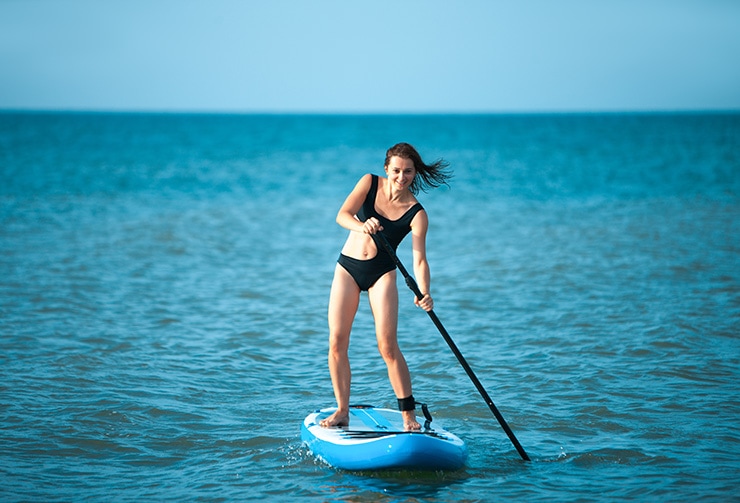The wind, and weather in general, can easily turn a beautiful paddle boarding session into a nightmare. Having the wind turn on you isn’t fun, and sometimes it can be dangerous.
But that doesn’t have to be the case. You can learn how to deal with a situation like this or, better still, avoid it completely. One way to do that is by understanding the weather and knowing when to go paddling and when to stay away from the water.
So how much wind is too much for paddle boarding? I’d say anything above 10 knots is too much wind for SUP. However, it depends on your skill level along with some factors too. Some paddlers can easily handle 10 knots.
Read on to know more.
RELATED: What Is Good Weather for Paddle Boarding?
What Is a Safe Wind Speed for Paddle Boarding?
The wind is a key factor in determining whether you’ll go paddling and how your SUP experience will be. So it’s important to know what wind speed would be considered safe.
Unfortunately, there’s no straightforward answer because every situation is completely unique, and a few factors come into play. A certain wind speed may be safe for one paddler but dangerous for another.
But as a general rule, anything under 7 knots (8 miles per hour) would be safe for everyone, including beginners.
Intermediate and experienced paddlers can handle higher wind speeds, even above 10 knots (11.5 miles per hour). But as you move past 15 knots (17 miles per hour), it gets less safe, regardless of your experience level. It’s less fun and even more dangerous if you’ll be paddling against the wind.
How Windy Is Too Windy for SUP?
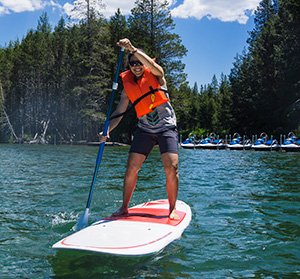
If the wind speed is above 10 knots, then it’s too windy for beginners to SUP. Strong winds translate to strong wind resistance if you have to paddle against the wind.
For experienced paddlers, if the wind speed is approaching 15 knots then it’s getting too windy.
Highly experienced paddlers can handle higher wind speeds and tougher wind conditions, especially for paddle surfing or downwinding.
The wind direction also determines whether or not it’s too windy for paddle boarding. A strong onshore wind may not be too much trouble. It will actually boost you and make your work easier when paddling back to shore.
But even a low-speed offshore wind can be annoying. Paddling against a strong wind when you’re heading back to shore, already tired from your session, is not a situation you want to find yourself in. This means that in addition to checking the wind speed, you shouldn’t forget the direction.
How to Check the Wind Before You Go Paddle Boarding
The weather changes a lot and you can’t perfectly predict it. But checking the weather forecast gives you an idea of what to expect, allowing you to prepare adequately.
There are lots of apps with a detailed wind forecast and you can use whichever one you like. However, I don’t recommend relying on just one app. Use at least three apps to get a more accurate prediction. Weather apps usually have different numbers so you can use several of them and get an average.
My favorite app for checking the wind is Windy. It offers detailed yet easy-to-understand information about wind speed and direction, wind gust, swell, waves, temperature, rain, and other weather factors.
WindAlert is another fantastic wind app for paddle boarders. It gives you real-time alerts on both the wind direction and speed.
So what important elements should you check?
- Wind speed
- Wind direction
- Wind gusts
- Waves
- Rain and thunder
Note: Check the weather forecast while planning your trip and again on the day of the trip. It’s also advisable not to focus solely on the area you’ll be paddling. Check the larger surrounding area too as the conditions there could affect your paddling session.
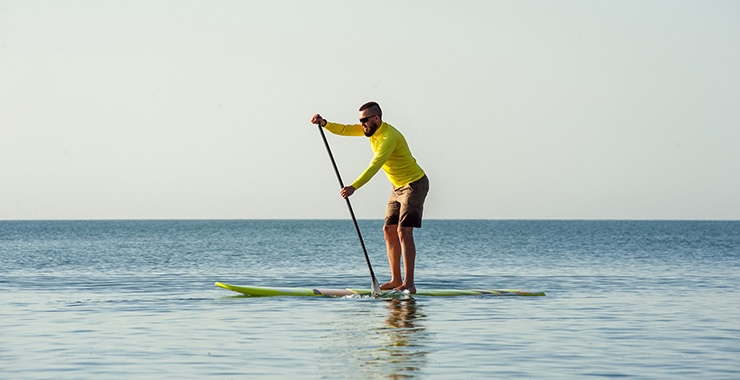
Plan Your Paddling Route Accordingly
Once you have an idea of what the wind and weather will be like, it’s time to get down to planning.
The best paddling trips for many paddlers would be when paddling in onshore winds. This is where the wind is blowing from the water towards the shore.
As you start your paddling trip heading out, you’ll be paddling against the wind. It’s a good way to challenge yourself as you’ll still have a lot of energy. Then when paddling back to shore, you’ll have the wind pushing you from behind, giving you a nice easy time.
Offshore winds can be a little trickier as they might push you farther out into the water than you want to go. And if the wind picks, you’ll struggle to paddle against it while heading back.
But you can’t always get the perfect wind conditions. One way to work around that is to plan your route such that you’ll get shelter from the wind. Maybe paddle while hugging the coastline or find a route with trees and cliffs to offer you shelter.
How to Paddle Safely on a Windy Day
Even with a solid plan, you can still encounter unexpected winds. Or maybe you don’t want windy days to keep you from going out on your paddle board.
You can paddle when it’s windy but there are safety precautions that you need to take seriously.
Here is how you can stay safe.
Watch Out for Changes in Wind Speed and Direction
As already mentioned, weather predictions are never perfect and conditions can change. SUP is such a fun activity and you can easily get lost in the beauty of nature and the peace of it all.
But you need to be alert the entire time you’re out on the water. Use your senses and your surroundings to tell the direction and speed of the wind. If you notice the wind picking up, it may be time to head back to shore before things get more serious.
If the wind direction changes, you may want to reassess and rethink your route.
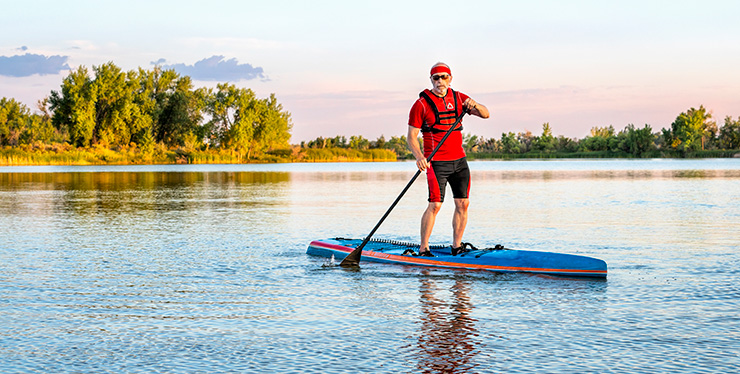
Don’t Overestimate Your Skill Level
Respect the water.
By this, I mean you should never overestimate your skills as a paddler, nor should you underestimate how dangerous the water can be. Don’t get yourself into a situation where you’re unable to cope with the conditions you face on the water.
This goes for beginners as well as more experienced paddlers. A heavy wind will result in choppy water and paddling will be much more challenging.
So it’s best to get out at the first sign of trouble, and don’t try and push on if you find yourself getting too tired.
Be Careful with Offshore Winds
Offshore winds blow from the shore towards the water (essential blowing ‘off the shore’ and toward the sea). If there’s an offshore wind, this means you’ll be paddling in the direction of the wind when heading out and paddling against the wind when coming back.
The problem with that is that if the wind is strong it can push you farther from land. If you aren’t alert, you may not even realize how far you’ve paddled because it feels easy. Paddling back will be tough, especially on a windy day. You’ll have to deal with more wind resistance while you’re already spent from your paddling trip.
In extremely windy conditions, it’s best to avoid offshore winds, more so if you’re a newbie. If you really must go out paddling when there’s an offshore wind, try to hug the coastline and don’t paddle too far out.
Kneel Down If the Wind Picks Up
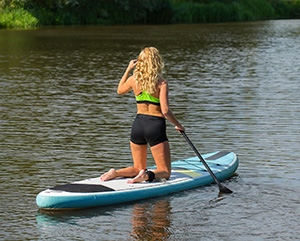
If you find yourself paddling against a stronger wind than you anticipated, don’t panic. You can still get back home safely.
The first thing you should do is get low. Your body acts as a sail and you’ll face a lot of resistance when paddling into the wind, so you’ll be putting in more effort while making little paddling progress.
Get on your knees to minimize the resistance and make your efforts more fruitful. If you’re still struggling, you can resort to prone paddling. Lie down on your stomach and use your arms to propel forward.
See if you can find shelter from trees or other landmarks.
Monitor the Conditions
In addition to using your senses, learn to monitor other conditions around you like the water texture.
The water texture can tell you quite a bit about the wind. If the waves are getting bigger, then you know the wind is getting stronger.
Always Wear a Leash and a PFD
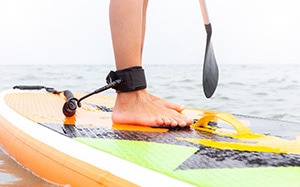
Both a board leash and a personal flotation device are key safety accessories that every paddler should wear at all times while out paddling.
In windy conditions and choppier waters, your chances of losing balance and falling into the water are higher.
A life vest will keep you afloat and prevent you from drowning. A leash ensures you remain attached to your paddle board even when you fall. So it won’t drift away, leaving you with nothing to float on.
If you find regular life vests too bulky, you can try an inflatable life belt or harness. Those are perfect for SUP and you won’t even notice them on you.
Get a Paddling Buddy
One of the most useful safety tips I can suggest for paddle boarding is to get a paddling buddy. If there are any problems such as if you suffer a puncture, or find yourself separated from your board – be it due to strong winds or for some other reason, you can use the other board to get back to safety.
Someone will have your back if things go wrong and you’ll have theirs.
Final Thoughts
How much wind is too much for paddle boarding? This depends on your skill level and the direction of the wind.
Generally, a wind speed of above 10 knots is too much for SUP. Highly experienced paddle boarders can handle stronger winds, some even up to 20 knots. It’s important to know your skill level and don’t overestimate what you can handle.
Be careful with offshore winds, those blowing from land to the water.
If you’re paddling in windy conditions, try to plan such that you paddle into the wind while heading out and in the direction of the wind while heading back. You can also find a route with cliffs, trees, and other landmarks to shield you from the wind.

